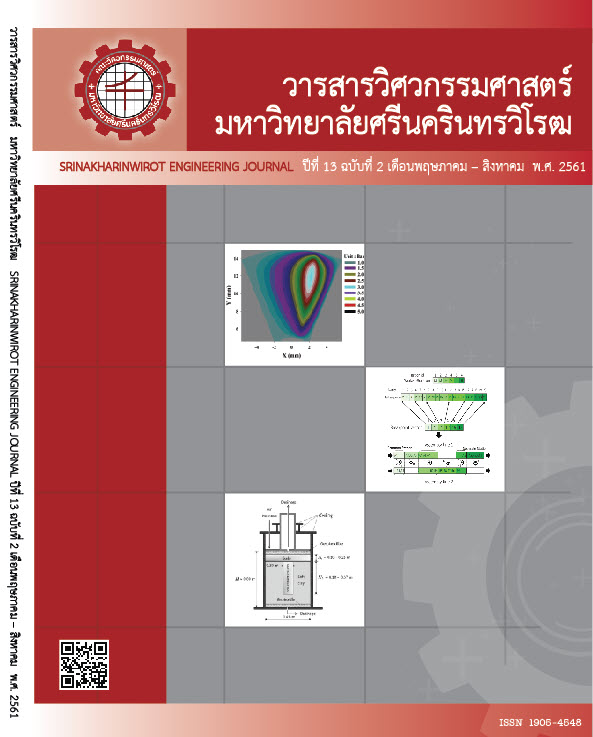A Confirmatory Factors Analysis of the Success factors on Government Construction Procurement Project
Main Article Content
Abstract
The purpose of this research is to examine the goodness of fit model of the Success factors on Government Construction Procurement Project. Data were collected from 353 procurement Staff from 353 Thai Government Agencies; the questionnaire was used a 1-5 rating scale of 22 question items. The questionnaire was tested by five experts, which item objective congruence (IOC) of .50-1.00, and reliability (a). of 0.986. The data were analyzed with second order of confirmatory factor analysis. The results showed that the questionnaire of four main factors: Scope and Coverage, Project Management, Legal Transactions and Contracts, and Administration and Management. The variance in successful Government Construction Procurement project is found at 61.2 percent. With reference to factor analysis, it was found that Scope and Coverage (β = 0.827) Project Management (β = 0.817) Legal Transactions and Contracts (β = 0.794) and Administration and Management (β =0.744) showed the highest factor loadings respectively.
Article Details
Copyright belongs to Srinakharinwirot University Engineering Journal
References
[2] V. Miller, Understanding Digital Culture, London, SAGE Publications Ltd., 2011.
[3] กองบริหารงานวิจัยและประกันคุณภาพการศึกษา. (23 ธันวาคม 2559). พิมพ์เขียว Thailand 4.0 โมเดลขับเคลื่อนประเทศไทยสู่ความมั่งคั่ง มั่นคง และยั่งยืน, [ระบบออนไลน์], แหล่งที่มา: www.libarts.up.ac.th/v2/img/Thailand-4.0.pdf.
[4] คณะกรรมการพัฒนาเศรษฐกิจและสังคมแห่งชาติ สำนักงาน. (20 มีนาคม 2558). การจัดทำแผนพัฒนาเศรษฐกิจและสังคมแห่งชาติ ฉบับที่ 12 (พศ.2560-2564), [ระบบออนไลน์], แหล่งที่มา: http://www.nesdb.go.th/more_news.php?cid=297
[5] H. Walker and S. Brammer, “Sustainable procurement in the United Kingdom public sector,” Supply Chain Manage., vol. 14, no. 2, pp. 128-137, 2009.
[6] S. Khoman, M. Wanrak, T. Vatcharceya, T. Chayun, C. Chatchai, S Sutthi, N. Sittikorn, and S. Napon, “The world trade organisation’s government procurement Agreement: A Study of Thailand’s preparation for accession,” Research report, The Comptroller-General’s Department, Ministry of Finance., Bangkok, October 2009.
[7] M. Podlogar, “E-Procurement Success Factors: Challenges and Opportunities for a Small Developing Country,” PA: IDEA Group Publishing, 2007, pp. 34-75.
[8] T. R. Berkland, “Performance based contracting and improving the current contracting process,” M.S. Thesis, Dept. Civil Eng., Clemson University, USA, 2007.
[9] B. Aschhoff and W Sofka, “Innovation on Demand: Can public procurement drive market success of innovations,” Research Policy, vol 38, no. 8, pp. 1235-1247, 2008.
[10] H. Doloi, K.C. lyer and A. Sawhney, “Structural equation model for assessing impacts of contractor's performance on project success,” Inter. J. Proj. Manage., vol. 29, pp. 687-695, 2011.
[11] N. Gudiene, A. Banaitis, N. Banaitiene and J. Lopes. “Development of a conceptual critical success factors model for construction projects: a case of Lithuania,” in 11th International Conference on Modern Building Materials, Structures and Techniques, Lithuania: Elsevier, 2013, pp. 392-397.
[12] S. M. H. M. Al-tmeemy, H. abdul-Rahman and Z. Harun, “Future criteria for success of building projects in Malaysia,” Inter. journal of PM, vol. 29, no. 3., pp. 337-348, 2011.
[13] J. I. Alzahrani, and M. W. Emsley, “The impact of contractors’ attributes on construction project success: A post construction evaluation,” Inter. J. Proj. Manage., vol. 31, no. 2., pp. 313-322, 2013.
[14] A. P. Field, Discovering Statistics Using IBM SPSS Statistics, London, SAGE Publications Ltd., 2012.
[15] W. Lawrence Neuman, Social Research Methods: Qualitative and Quantitative Approaches, Boston: Pearson/AandB, 2006.
[16] ชัยวิชิต เชียรชนะ. “การใช้สถิตหลายตัวแปรเพื่อการวิจัย: การออกแบบ การวิเคราะห์ และตีความหมาย,” กรุงเทพมหานคร, โรงพิมพ์แห่งจุฬาลงกรณ์มหาวิทยาลัย, 2549.
[17] R. B. Kline, Methodology in The Social Sciences. Principles and Practice of Structural Equation Modeling, NY, USA: Guilford Press., 2005.
[18] สุภมาส อังศุโชติ, สมถวิล วิจิตรวรรณา และ รัชนีกูล ภิญโญภานุวัตน์. “สถิติวิเคราะห์สำหรับการวิจัยทางสังคมศาสตร์และพฤติกรรมศาสตร์: เทคนิคการใช้โปรแกรม LISREL,” กรุงเทพมหานคร, มิสชั่นมีเดีย, 2551.
[19] ยุทธ ไกยวรรณ์, “การวิเคราะห์โมเดลสมการโครงสร้างด้วย Amos,” กรุงเทพมหานคร, สำนักพิมพ์แห่งจุฬาลงกรณ์มหาวิทยาลัย, 2556.
[20] นงลักษณ์ วิรัชชัย. “โมเดลลิสเรล: สถิติวิเคราะห์สำหรับการวิจัย,” พิมพ์ครั้งที่ 3, กรุงเทพมหานคร, โรงพิมพ์แห่งจุฬาลงกรณ์มหาวิทยาลัย, 2542.
[21] L. Hu and B. M. Peter, “Cutoff criteria for fit indexes in covariance structure analysis: conventional criteria versus new alternatives,” Struct. Equ. Modeling., vol. 6, no. 1., pp. 1-55, 1999.
[22] J. F. Hair, W. C. Black, B. J. Babin, R. E. Anderson and R. L. Tatham, Multivariate data analysis, New Jersey: Prentice Hall, 2006.
[23] พูลพงศ์ สุขสว่าง. “หลักการวิเคราะห์โมเดลสมการโครงสร้าง,” วารสารมหาวิทยาลัยนาธิวาสราชนครินทร์, ปีที่ 6, ฉบับที่ 2, หน้า 136-145, 2557.
[24] สำนักนายกรัฐมนตรี. (23 กุมภาพันธ์ 2561).ระเบียบสำนักนายกรัฐมนตรีว่าด้วยการพัสดุ พ.ศ. 2535 และที่แก้ไขเพิ่มเติม, [ระบบออนไลน์]. แหล่งที่มา: http://www.anti-corruption.ops.go.th/files/การป้องกันการทุจริต/2535.pdf


